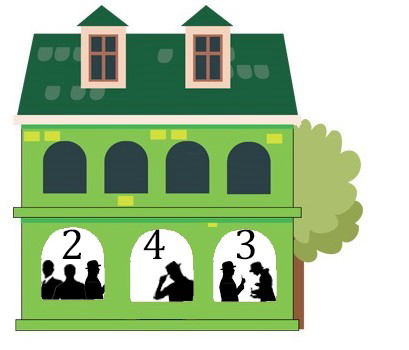Problems
Can you find a quadrilateral (i.e: a shape with four sides) that can be divided into \(6\) shapes (not necessarily congruent) by using only two straight cuts?
Is it possible to cut such a hole in \(10\times 10 \,\,cm^2\) piece of paper, though which you can step?
A square \(4 \times 4\) is called magic if all the numbers from 1 to 16 can be written into its cells in such a way that the sums of numbers in columns, rows and two diagonals are equal to each other. Sixth-grader Edwin began to make a magic square and written the number 1 in certain cell. His younger brother Theo decided to help him and put the numbers \(2\) and \(3\) in the cells adjacent to the number \(1\). Is it possible for Edwin to finish the magic square after such help?
Cut a square into \(3\) parts which you can use to construct a triangle with angles less than \(90^{\circ}\) and three different sides.
Suppose that a rectangle can be divided into \(13\) equal smaller squares. What could be the side lengths of this rectangle?
Cut a square into two equal:
1. Triangles.
2. Pentagons
3. Hexagons.
The meeting of the secret agents took place in the green house.

Considering the numbers in the windows of the green house, what
should be drawn in the empty frame?

Today we will practice to encrypt and decipher information using some
of the most common codes. Majority of the codes in use can be alphabetic
and numeric, namely one may want to encode a word, a phrase, or a
number, or just any string of symbols using either letters, or numbers,
or both. Some of the codes, however may use various other symbols to
encrypt the information. To solve some of the problems you will need the
correspondence between alphabet letters and numbers
0.85
@*26c@ A & B & C &
D &E & F &G &H &I &J &K &L
&M&N&O&P&Q&R&S&T&U&V&W&X&Y&Z
1 & 2 &
3&4&5&6&7&8&9&10&11&12&13&14&15&16&17&18&19&20&21&22&23&24&25&26
Find one way to encrypt letters of Latin alphabet as sequences of \(0\)s and \(1\)s, each letter corresponds to a sequence of five symbols.
Pinoccio keeps his Golden Key in the safe that is locked with a
numerical password. For secure storage of the Key he replaced some
digits in the password by letters (in such a way that different letters
substitute different digits). After replacement Pinoccio got the
password \(QUANTISED17\). Honest John
found out that:
• the number \(QUANTISED\) is divisible
by all integers less than 17, and
• the difference \(QUA-NTI\) is
divisible by \(7\).
Could he find the password?